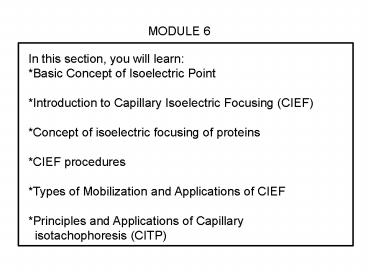MODULE 6 - PowerPoint PPT Presentation
1 / 50
Title: MODULE 6
1
MODULE 6
In this section, you will learn Basic Concept
of Isoelectric Point Introduction to Capillary
Isoelectric Focusing (CIEF) Concept of
isoelectric focusing of proteins CIEF
procedures Types of Mobilization and
Applications of CIEF Principles and
Applications of Capillary isotachophoresis
(CITP)
2
(No Transcript)
3
(Continued)
4
Isoelectric Point (Continued)
5
- What are the sign of charges on the proteins in
the pI list when in buffers with - pH 1.0
- --------------------------------------------------
--------------------------------------------------
--------
(b) pH 5.0 --------------------------------------
--------------------------------------------------
--------------------
(c) pH 8.0 --------------------------------------
--------------------------------------------------
--------------------
6
(No Transcript)
7
(No Transcript)
8
Carrier Ampholytes Buffers (Continued)
9
(No Transcript)
10
(No Transcript)
11
Procedure for CIEF
12
(No Transcript)
13
(No Transcript)
14
(No Transcript)
15
Procedure for CIEF (continued)
16
CIEF Procedures
17
(No Transcript)
18
(No Transcript)
19
(No Transcript)
20
(No Transcript)
21
(No Transcript)
22
(No Transcript)
23
(No Transcript)
24
(No Transcript)
25
Neutral and basic proteins are effectively mobiliz
ed toward cathode with NaCl and mobilization time
correlates well with the pI.
Because the plot of mobilization time vs. pI
gives a straight line the pI value of unknown
protein can be determined. However, acidic
proteins at far end of the capillary are
mobilized with lower N and may go undetected
26
(No Transcript)
27
(No Transcript)
28
More on Vacuum Mobilization
29
Comparison of Mobilization Techniques
30
Comparison of Mobilization Techniques
31
Comparison of Mobilization Techniques
Chemical Mobilization
Hydrodynamic Mobilization
EOF Mobilization
32
(No Transcript)
33
CIEF of Hemoglobins using PVA coated capillary
34
Capillary Isotachophoresis
35
Principles of ITP
36
Another interesting feature of ITP is the
constant concentration in each zone, determined
by the concentration of the leading electrolyte.
Since ITP is usually performed in constant
current mode, a constant ratio must exist between
the concentration and the mobility of the ions
in each zone.
Zones that are less, or more, concentrated than
the leading electrolyte are sharpened, or
broadened, to adopt to the proper concentration.
The solute- concentration principle of ITP has
been used as a preconcentration step prior to
CZE, MEKC, and CGE
37
(No Transcript)
38
Student notes a) The same is dissolved in the
LE (aka support buffer or BGE). The sample is
dissolved in LE and a large volume and is
injected into the capillary. The injection end
of the capillary is then placed into a reservoir
containing the TE
b) Voltage is applied for a fixed time to focus
the sample into sharp ITP bands.
c) After the sample is focussed, the capillary is
removed from the TE buffer reservoir and placed
in the support buffer reservoir. The voltage is
then re-applied to separate the sample by the
normal CE process
39
(No Transcript)
40
(No Transcript)
41
(No Transcript)
42
(No Transcript)
43
(No Transcript)
44
(No Transcript)
45
(No Transcript)
46
(No Transcript)
47
(No Transcript)
48
Capillary Electrophoresis for Chiral Analysis
49
Chiral Selectors in CE
50
(No Transcript)































